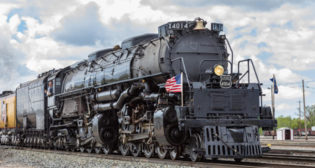
FreightWaves SONAR: Need For Speed Drives Ships To Pacific Ports
Written by Greg Miller, Senior Editor, FreightWaves
Port of Los Angeles
The battle for Asian containerized exports rages on between West and East Coast ports. The East had been steadily gaining ground, but COVID-19 is changing the balance in favor of the West, at least in the short term. The most immediate effect of the coronavirus was a shift from air cargo to premium ocean service. Advantage West Coast ports. Former air-cargo shippers with time pressures don’t take the long route to the East Coast.
Nerijus Poskus, head of ocean at freight forwarder Flexport, pointed to the rise of premium services that offer guaranteed loading, faster ocean transits and priority discharge. He told FreightWaves that “once people shift from air to premium ocean, it will prove difficult to shift back” as supply chains become accustomed to premium ocean.
Matson and CMA CGM subsidiary APL traditionally offered premium services, with Matson recently adding extra sailings. In addition, ZIM has unveiled a new premium service—12 days from China to California.
The second COVID-19 effect was driven by the surge in e-commerce popularity among locked-in consumers. More e-commerce could incentivize shorter delivery times from Asia. Yet again: advantage West Coast.
“The competitiveness of e-commerce and how it has driven shortened lead times has created even more demand for vessel services that offer guaranteed and expedited transit times,” said FreightWaves Maritime Market Expert Henry Byers.
“It’s simply a risk some companies are not willing to mess with anymore,” said Byers of delivery time. “They would rather pay twice the amount for a specific portion of their containers than risk failing to service their customers. It’s still cheaper than air freight.”

ZIM’s new premium service is branded “ZEX,” short for “ZIM E-commerce Xpress.” It was specifically launched “to cater to the increasing needs of e-commerce customers, especially now due to growing e-commerce demand following the COVID-19 crisis.”
The third COVID-19 effect involves recovery timing.
Demand for containerized cargo has recovered as states have reopened their economies. But demand may fall again due to rising infections, business failures and unemployment. If shippers are not convinced of demand sustainability, they may avoid putting cargo on the longer Asia-East Coast route, which can involve five to six weeks at sea.
Lars Jensen, CEO of Copenhagen-based SeaIntelligence Consulting, speculated in an online post that U.S. importers might be “only expecting a brief, temporary pickup and hence want their product shipped to the U.S. as quickly as possible,” i.e., to the West Coast.
The counterargument is that all of these West Coast advantages are temporary and do not alter the long-term shift that was under way before the coronavirus crisis. Advantage — big advantage — to the East Coast.

This trend has major implications for land transport. The less volume into West Coast ports, the less cargo railed cross-country to Eastern states, and the more trucked westward from Eastern ports. More volume by sea to the East Coast effectively equals higher demand for trucking and less for rail, and vice versa if the pendulum swings to West Coast ports.
Deutsche Bank transportation analyst Amit Mehrotra told FreightWaves, “The West-to-East shift is a secular theme, one that will play out over a long period of time. Cyclical forces at any given time are going to outweigh those secular trends, and in this context, the ports of Los Angeles, Long Beach and Oakland are still incredibly important. But the underlying trend is incredibly clear. I agree that there may be a rush to get things over [due to COVID-19] but keep in mind that the 60% of the population lives east of the Mississippi River. At the end of the day, if you come into the West Coast, you’re going to have to rail a lot of it east, where the major demand centers are. And with the expansion of the Panama Canal and the port projects on the East Coast, which allow for bigger ships, and with the majority of the population in these states, it disproportionately favors the East Coast ports.”
“I agree that e-commerce is very important,” continued Mehrotra. “If you ordered toothpaste 10 years ago, you’d be happy if you got it in five or six days. Now you want it the next day. Two years from now, you’ll want it the same day. That can only happen if it’s close to you to begin with. You might say if it’s all about speed and it takes longer to bring a ship to the East Coast, then that’s a hole in the whole thesis. But it’s not a hole. “In the past, you could have one massive distribution center in the center of the country, have cargo come off the container ship on the West Coast, rail it inland to the distribution center, then use trucks to feed from that hub. Now what’s happening instead is you need speed in the last mile. So, you need multiple e-commerce fulfillment centers throughout the East. More container-ship traffic will come to the East [due to higher demand for e-commerce] and you won’t need speed on the ocean part, you’ll need speed on the last mile.”

FreightWaves SONAR offers the most essential rail and intermodal data available, with daily updates on rail and intermodal pricing and volumes. Additionally, compare rail market trends against other modes of transportation to gain a comprehensive view of logistics markets. Users can react faster than ever to changing market conditions, giving them an advantage never before seen in freight. To learn more and schedule your personal free trial, click here.



